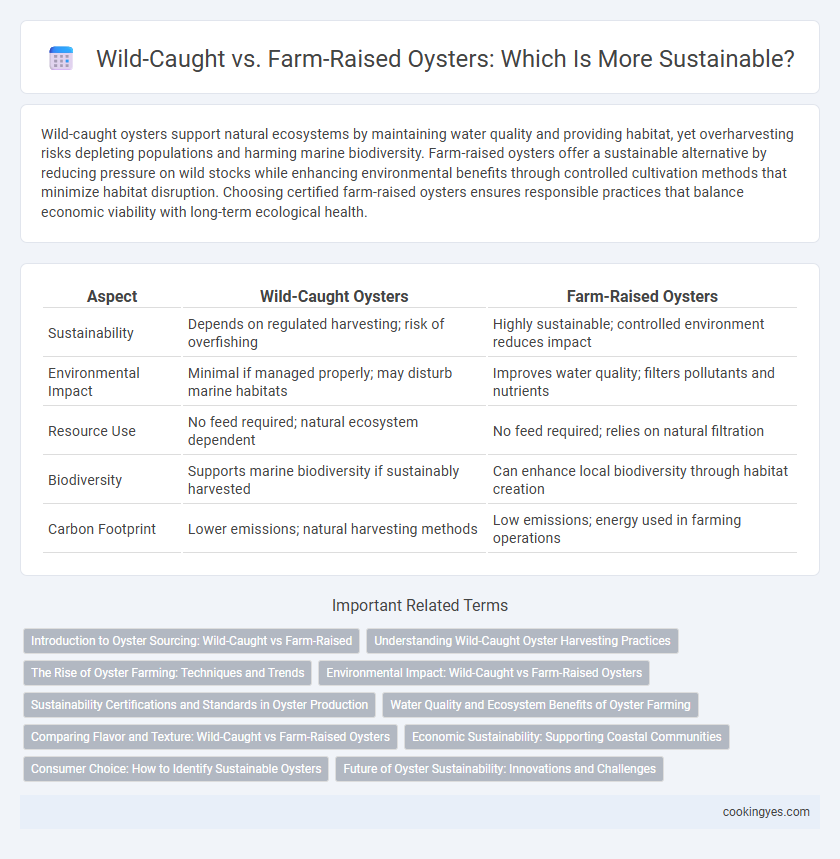Wild-caught oysters support natural ecosystems by maintaining water quality and providing habitat, yet overharvesting risks depleting populations and harming marine biodiversity. Farm-raised oysters offer a sustainable alternative by reducing pressure on wild stocks while enhancing environmental benefits through controlled cultivation methods that minimize habitat disruption. Choosing certified farm-raised oysters ensures responsible practices that balance economic viability with long-term ecological health.
Table of Comparison
| Aspect | Wild-Caught Oysters | Farm-Raised Oysters |
|---|---|---|
| Sustainability | Depends on regulated harvesting; risk of overfishing | Highly sustainable; controlled environment reduces impact |
| Environmental Impact | Minimal if managed properly; may disturb marine habitats | Improves water quality; filters pollutants and nutrients |
| Resource Use | No feed required; natural ecosystem dependent | No feed required; relies on natural filtration |
| Biodiversity | Supports marine biodiversity if sustainably harvested | Can enhance local biodiversity through habitat creation |
| Carbon Footprint | Lower emissions; natural harvesting methods | Low emissions; energy used in farming operations |
Introduction to Oyster Sourcing: Wild-Caught vs Farm-Raised
Wild-caught oysters are harvested from natural habitats, preserving local ecosystems but facing sustainability challenges due to overfishing risks. Farm-raised oysters are cultivated in controlled environments, offering a sustainable solution by reducing habitat disruption and supporting consistent production. Emphasizing sustainable sourcing, farm-raised oysters contribute to healthier marine ecosystems while meeting growing global demand.
Understanding Wild-Caught Oyster Harvesting Practices
Wild-caught oyster harvesting involves collecting oysters from their natural habitats in coastal waters, often using methods like hand-picking or dredging that minimize habitat disruption when managed sustainably. These practices support biodiversity by allowing oyster populations to reproduce and maintain ecosystem balance, enhancing water filtration and shoreline protection. Sustainable wild-caught oyster harvesting relies on regulated seasons, size limits, and habitat conservation to prevent overharvesting and ensure long-term viability of oyster stocks.
The Rise of Oyster Farming: Techniques and Trends
Oyster farming has risen as a sustainable alternative to wild-caught harvesting by employing techniques such as off-bottom culture, suspended longlines, and reef restoration, which reduce environmental impact and promote ecosystem health. Advances in aquaculture technology and selective breeding improve yield and disease resistance, supporting consistent and eco-friendly oyster production. Current trends emphasize integrated multi-trophic aquaculture (IMTA), combining oysters with other species to enhance nutrient cycling and marine biodiversity.
Environmental Impact: Wild-Caught vs Farm-Raised Oysters
Wild-caught oysters contribute to ecosystem balance by naturally filtering water and providing habitat, but overharvesting can damage reefs and reduce biodiversity. Farm-raised oysters often have a lower environmental footprint, using less energy and chemical inputs while enhancing water quality through biofiltration. Sustainable oyster farming practices prioritize site selection and density control to minimize ecological disruption, promoting healthier coastal environments compared to unmanaged wild populations.
Sustainability Certifications and Standards in Oyster Production
Wild-caught oysters are often certified by organizations such as the Marine Stewardship Council (MSC), ensuring sustainable harvesting practices that protect natural ecosystems. Farm-raised oysters commonly adhere to standards set by the Aquaculture Stewardship Council (ASC), which promotes environmentally responsible farming methods, including water quality management and habitat conservation. Choosing oysters with these sustainability certifications supports ecological balance and responsible seafood consumption.
Water Quality and Ecosystem Benefits of Oyster Farming
Wild-caught oysters rely on natural water conditions and can be affected by pollution, posing challenges for sustainability. Farm-raised oysters improve water quality by filtering excess nutrients and reducing eutrophication, enhancing overall ecosystem health. Oyster farming supports biodiversity, provides habitat structure, and promotes sustainable seafood production with lower environmental impact compared to wild harvesting.
Comparing Flavor and Texture: Wild-Caught vs Farm-Raised Oysters
Wild-caught oysters typically exhibit a brinier, more complex flavor profile and a firmer texture due to their natural diet and ocean environment. Farm-raised oysters offer a milder taste and softer texture, influenced by controlled growing conditions and curated feed. The distinct flavor and texture differences between wild-caught and farm-raised oysters impact culinary applications and consumer preferences while reflecting varying sustainability practices.
Economic Sustainability: Supporting Coastal Communities
Wild-caught oysters generate significant economic benefits by supporting fisheries and providing livelihoods for coastal communities, fostering local employment and preserving traditional harvest practices. Farm-raised oysters contribute to economic sustainability by offering a reliable, scalable source of income, which helps stabilize markets and reduces over-reliance on wild stocks. Both methods promote coastal economic resilience, but integrating wild harvest with aquaculture practices enhances long-term community prosperity and resource stewardship.
Consumer Choice: How to Identify Sustainable Oysters
Consumers seeking sustainable oysters should prioritize wild-caught varieties harvested from well-managed coastal areas with certified sustainable fisheries, ensuring minimal environmental impact and maintaining ecosystem balance. Farm-raised oysters produced through responsible aquaculture practices, such as integrated multi-trophic systems, can also offer sustainable options by enhancing water quality and reducing overfishing pressures. Identifying sustainable oysters involves looking for certifications like MSC (Marine Stewardship Council) for wild-caught or ASC (Aquaculture Stewardship Council) for farm-raised, alongside transparent sourcing information from reputable suppliers.
Future of Oyster Sustainability: Innovations and Challenges
Wild-caught oysters provide natural ecosystem benefits such as water filtration and habitat support, but face challenges from overharvesting and environmental degradation. Farm-raised oysters utilize aquaculture techniques that enhance production efficiency and reduce pressure on wild populations, yet they must navigate issues like disease management and habitat alteration. Innovations in oyster farming, including selective breeding for disease resistance and integrated multi-trophic aquaculture, are critical for sustainable oyster production amid changing environmental conditions.
Wild-caught vs farm-raised for sustainability Infographic

 cookingyes.com
cookingyes.com